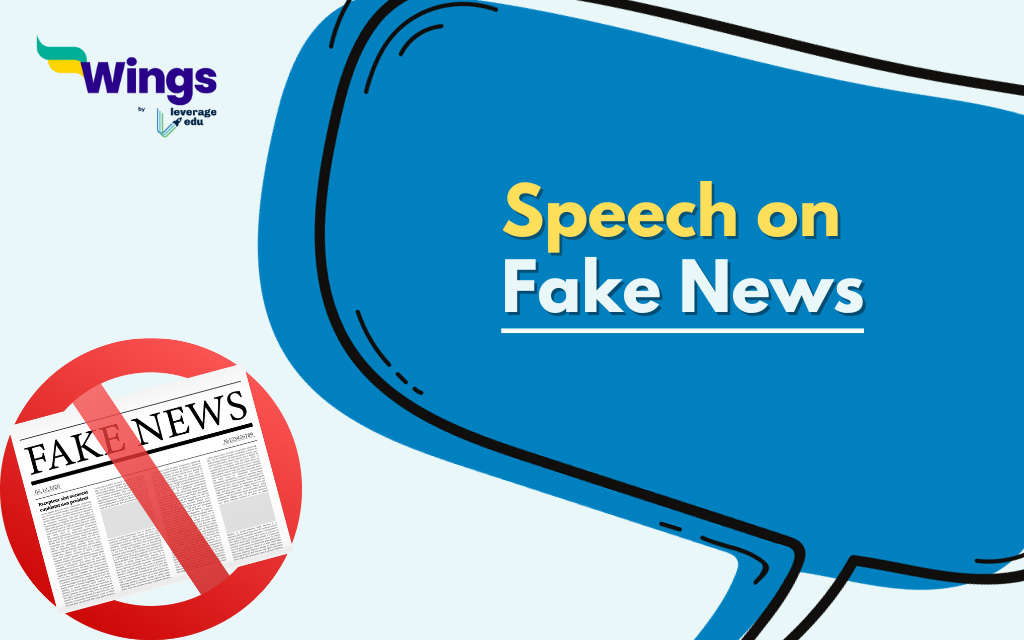Speech on Fake News: Clicking on clickbait is not so uncommon nowadays. Social media has become one of the easiest online platforms for spreading fake news to earn online fame and money. The reason behind making fake news is simple: fame and money.
According to the research team from USC Marshall School of Business and USC Dornsife College of Letters Arts and Science, social media maintains a rewards system that encourages users to keep posting and sharing fake news.
The reward-based system soon turns into a habit and once a habit is formed CUE, a browser-based publishing platform gets activated without considering the results.
Also Read: Advantages and Disadvantages of Social Media
2-minute Speech on Fake News
Greetings to all the teachers and students gathered here. Today, I stand before you to deliver my point of view on the topic of fake news. In this speech, I have covered the origin of fake news, its impact and how we can stay conscious of spreading fake news.
In today’s interconnected world, we are bombarded with information from different sources. However in this sea of information, one cannot remain untouched by fake news. Fake news can be defined as a piece of misleading presented as genuine but poses a significant threat to our society.
The rapid distribution of information fuels the expansion of fake news. The primary sources of such proliferation are social media platforms and online news outlets. The misinformation from these sources is spread like wildfire and sows the seeds of confusion and distrust among people. It deteriorates the foundations of a well-informed society by distorting reality and manipulating public opinion.
Consider the impact of fake news on elections, public health, and social unity. Fake narratives can influence the voters, erode public health efforts, and create community divisions. Unfortunately, it is sad and disappointing that the consequence of unchecked misinformation is intense and far-reaching.
One must adopt a critical mindset to fight against the misinformation of fake news. Before sharing any news, the preventive measure can be fact-checking and verifying the information at least twice. The media literacy program can also help individuals distinguish between reliable and unreliable sources.
Furthermore, by educating ourselves and others with more social media fact-check awareness, we can build a resilient society less vulnerable to the destructive effects of misinformation.
Journalist honesty is also essential while getting saved and aware of the fake news. News organizations must understand their responsibility and should fact-check the standards with transparency. The burden of safeguarding oneself from misinformation and fake news falls not only on the creators but also on the consumers. They should check the accuracy and accountability of the news from time to time.
Also Read: Cyber Etiquette: 11 Rules of Online Etiquette for Students
10 Lines on Fake News
1. Fake news is like stories that are not true and can be found easily on the internet and social media.
2. People make fake news to trick people and trick them into believing or creating confusion.
3. It is important to be careful and check if a story is real or not before sharing it anywhere on social media.
4. Sometimes, fake news is made to get attention or make people believe things that are not true.
5. It is suggested to look for other sources or news websites to ensure that it is not just someone making things up.
6. It is important that one should learn about trustworthy websites, sources, and reliable websites.
7. One should be careful if something sounds too crazy and weird.
8. People should be intelligent news detectives and share only the real stuff with their known ones.
9. If one is unsure about a piece of news or story, one should ask a grown-up or a teacher for help in guiding whether the news is reliable or not.
10. Together, we can stop fake news from spreading and fooling us. We should work on the fact that we are sharing the truth.
FAQs
Fake news is false information presented on social media as if it were true. It is often created to mislead or deceive people.
One should look for reliable sources and should check if other news outlets are reporting the same information.
Fake news creates confusion and spreads misinformation among individuals. Sometimes fake news even influences public opinion on a large scale which can create a problem in society.
Before sharing any news, it is recommended to use a fact check through official websites. Also, it is important to be cautious of sharing information that seems too sensational.
Fake news is false or misleading information presented as if it were genuine news. This misinformation can be created intentionally to deceive or mislead people. Fake news can be spread as fabricated stories, misleading headlines or distorted facts. fake news often spreads through social media platforms, making it challenging for individuals to discern accurate information from false content.
Related Blogs
For more information on such interesting speech topics for your school, visit our speech writing page and follow Leverage Edu.
 One app for all your study abroad needs
One app for all your study abroad needs














